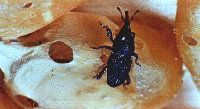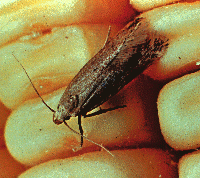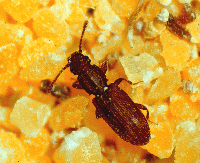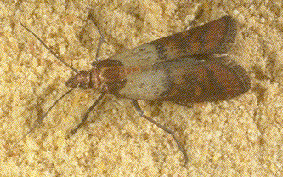Stored Product Pests in the Pantry
ENTFACT-612: Stored Product Pests in the Pantry | Download PDF | En Español
by Lee Townsend, Extension Entomologist
University of Kentucky College of Agriculture

Rice Weevil
Stored product or pantry pests include several beetles, moths, and a mite that can infest whole grains or processed foods. Usually, the first sign of a problem is the appearance of small beetles crawling over counter tops, moths flying across rooms, or caterpillars crawling up walls or across ceilings. The solution requires finding and destroying all infested products in which these pests have developed, a general cleanup, and use of sealed storage containers to prevent recurring problems.
Some stored product pests feed inside whole kernels. These include the granary weevil, rice weevil, and the Angoumois grain moth.
Rice weevils are 1/8- to 1/4-inch long, reddish brown to black snout beetles. Adults can live for 6 to 8 months and may be found some distance from infested articles.
The larval stage is a legless grub that develops inside kernels of wheat or corn, or other whole grains or caked materials. Development from egg to adult takes as little as 1 month.

Angoumois Grain Moth
The Angoumois grain moth is 1/2 inch long and pale yellow brown. It may be seen fluttering in the house. As with the weevils, the larval stage develops in whole kernels or caked grain. Barley, rye, corn, oats, rice and various other seeds can be infested. Decorative ear corn is a common source of the insect. The life cycle takes about 6 weeks. The adult resembles a clothes moth but can be recognized by the finger-like projection of the hind wing tip.
A much larger number of insects feed on processed grains or broken kernels, or a variety of spices. Common pests include the red and confused flour beetles, sawtoothed grain beetles, drugstore beetle, cigarette beetle and Indian meal moth.

Sawtoothed Grain Beetles
Red and confused flour beetles, cigarette beetles, drugstore beetles, and the sawtoothed grain beetles are 1/8 inch long red brown insects. The immature or larval stages usually occur only in infested products and usually are not seen.
Flour beetles and the sawtoothed grain beetle cannot attack whole or undamaged grains but will feed on a wide variety of processed grains (flour, meal), as well as dried fruits, dry dog food, dried meats, candy bars, drugs, tobacco, and a variety of other products. The life cycle of the flour beetles takes about 7 weeks. Adult females can live for several months to more than a year. Confused flour beetles fly and are attracted to lights; red flour beetles crawl toward light but apparently do not fly. Sawtoothed grain beetles neither fly nor are they attracted to light.

Drugstore Beetle
Drugstore beetles and cigarette beetles attack almost any household food and spice and leather articles. Cigarette beetles are most commonly found in dried dog food and paprika. Drugstore beetles are often in bread, flour, meal, breakfast foods, and spices like red pepper. Adults of both species can fly and are attracted to light.
The Indian meal moth is a very common household pest. The distinctive 1/2-inch long adult is easily recognized by the pale gray and coppery brown front wings. The dirty white to pink larval stage is a caterpillar that crawls away from the infested products to find a place in which to transform to the adult. The caterpillars feed on the surface and produce silk webbing throughout the food source. The life cycle can be as short as 25 days.

Indian Meal Moth
They can feed in dried fruits, powdered milk, chocolate, flour, meal, dried dog food, bird seed and a variety of food stuffs. They prefer coarse flours and corn meal.
Control
While adults are the signs of an infestation, merely killing them is not the solution. Infested articles must be found and destroyed. Identification of the pest can provide clues on where to look but some of these insects can live on a wide range of materials.
In general, the greater the number of insects seen, the older the infestation. Often the initial source is partially used boxes or bags of products that have been forgotten in the backs of pantries and shelves. The infestation spreads as the active adults search for new food sources. A thorough search is needed to locate all infested items. If they are not found in pantries or cupboards, then begin to look at such things as decorative items or bird seed.
Disposal of infested materials is the best way to eliminate the problem. Also check all items in pantries or on shelves. Often beetles can be found beneath cans and other items. Thoroughly vacuum the shelves, both upper and lower surfaces, and use a crevice attachment to clean cracks and crevices. It is better to do a very thorough job one time than to have to repeat a hasty inspection and cleanup.
After treatment, good sanitation and proper storage are keys to preventing future problems. Place products from cardboard, paper, or plastic containers into jars or other containers that can be sealed tightly. Decorative items such as indian corn, dried flower arrangements, or bird feed may be treated with heat (155°F for about 20 minutes with the oven door propped open) or in a non-self- defrosting freezer at 0°F for 4 days.
Revised: 11/97
CAUTION! Pesticide recommendations in this publication are registered for use in Kentucky, USA ONLY! The use of some products may not be legal in your state or country. Please check with your local county agent or regulatory official before using any pesticide mentioned in this publication.
Of course, ALWAYS READ AND FOLLOW LABEL DIRECTIONS FOR SAFE USE OF ANY PESTICIDE!
Drugstore beetle & sawtoothed grain beetle photos: Ric Bessin, University of Kentucky Entomology. Other images: USDA Insect and Plant Disease Slide Set.
